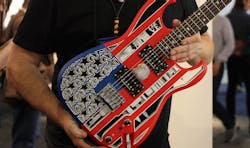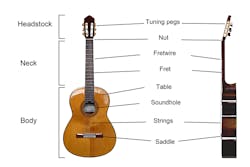3D Printing of Musical Instruments Tries to Find a Rhythm
We’ve seen 3D printing move into many industries: automotive, aviation, gaming, etc., just about anywhere there’s a need for complex or custom parts. But what’s the story with the music industry? Some companies and artists have been 3D-printing instruments layer by layer, but it seems the trend is more of a way to create attention than music. This article looks at 3D printing’s current status in this sector, and if or when it might change the musical instrument market.
The shape and material of an instrument is imperative to its sound. With the ability to make almost any shape imaginable, 3D printing sounds like it could produce the most visibly and audibly stunning instruments. And with the cost of most musical instruments, 3D printing may help offer some relief along those lines. So why has it not dominated this industry?
There are other instruments to print, but even many drums have diameters well outside the build space of most printers (by tales of a wandering youkai from Arvada, CO, US (3D-printed drums) [CC BY 2.0 (http://creativecommons.org/licenses/by/2.0)], via Wikimedia Commons.
There are a few reasons why 3D printing isn’t and probably won’t dominate the music industry. For one, traditionalists may not take artistic 3D-printed plastic instruments seriously. Also, because they’re plastic and made with automated machinery, it may greatly affect a musician’s buying decision.
Even if you’re not a traditionalist, availability may limit the ability of 3D printing to disrupt the musical instrument industry. If you walk into a store and ask for a 3D-printed instrument, you may very well get a sideways glance. Also, while cost of 3D printing has dramatically reduced, extruding plastic is still the easiest to afford and access. While it can produce recorders, much like those some of us would play in elementary school, this isn’t the instrument most people are looking for.
Some guitar printers use nylon in a powder-bed laser-sintering process. This can be costly, but the increased strength and resolution may be why manufacturers use this method. Finishing is labor-intensive, and having a finer resolution would reduce the time needed to get the smooth finish desired by a designer. A powder-bed process is more expensive, and maybe one of the reasons a 3D-printed guitar can run over $1,300. However, it is important to remember that much of the cost will be wrapped up in the electronics you decide to use, which can exceed $500.
By Maurizio Pesce from Milan, Italy (3DSystems 3D-printed electric guitar) [CC BY 2.0 (http://creativecommons.org/licenses/by/2.0)], via Wikimedia Commons.
Acoustically Speaking…
In addition, printing in plastic isn’t the best acoustic material to create an instrument. Plastic doesn’t resonate, i.e., plastic sounds horrible. This could be the main reason why we don’t see more printed instruments. There are other materials, but metal is still a bit pricey and some of the harder plastics may need printers with higher thermal capabilities.
On top of that, the build spaces of most 3D printers are only about one cubic foot. This isn’t only for metal printers, but also for the extruded plastic printers. Instruments can be built in pieces, but adding joints could worsen the sound, or create air leaks. Finally, it takes time to learn where and how to use 3D printing in an application.
One particular application is the electric guitar. Because it’s electric, the acoustics of the plastic generally don’t matter, and some people have a lot of experience printing guitars. And since the electronics of the guitar have advanced over the years, printing the body of a guitar isn’t as acoustically important.
By Sluffs (Photographer: Martin Möller English text by Sluffs) [CC BY-SA 3.0 (http://creativecommons.org/licenses/by-sa/3.0)], via Wikimedia Commons.
Most of the guitar can be centralized to the area of the neck and core—the part where the pickups are mounted. Check out this video on making a 3D-printed guitar:
Some original 3D-printed designs would print almost any type of body desired. The neck and core assembly then slide into the 3D-printed body. The core and neck maintain the acoustic properties, and the body is more or less for looks.
Fun fact: Early designers would use mahogany if they wanted the guitar to sound like a Gibson, and use maple if they wanted the instrument to sound like a Fender Strat or Telecaster.
The bread-and-butter of 3D printing is the printing of complex, small parts. Most musical instruments are made effectively with traditional processes, and they aren’t small. Though 3D-printed instruments are cool, they may remain a niche product that will likely not disrupt the instrument market in the near future.




